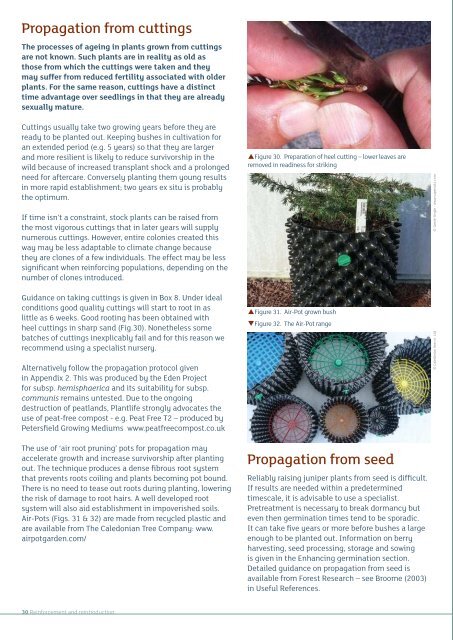Breaking new ground for juniper - Plantlife
Breaking new ground for juniper - Plantlife
Breaking new ground for juniper - Plantlife
- No tags were found...
Create successful ePaper yourself
Turn your PDF publications into a flip-book with our unique Google optimized e-Paper software.
Propagation from cuttingsThe processes of ageing in plants grown from cuttingsare not known. Such plants are in reality as old asthose from which the cuttings were taken and theymay suffer from reduced fertility associated with olderplants. For the same reason, cuttings have a distincttime advantage over seedlings in that they are alreadysexually mature.Cuttings usually take two growing years be<strong>for</strong>e they areready to be planted out. Keeping bushes in cultivation <strong>for</strong>an extended period (e.g. 5 years) so that they are largerand more resilient is likely to reduce survivorship in thewild because of increased transplant shock and a prolongedneed <strong>for</strong> aftercare. Conversely planting them young resultsin more rapid establishment; two years ex situ is probablythe optimum.If time isn’t a constraint, stock plants can be raised fromthe most vigorous cuttings that in later years will supplynumerous cuttings. However, entire colonies created thisway may be less adaptable to climate change becausethey are clones of a few individuals. The effect may be lesssignificant when rein<strong>for</strong>cing populations, depending on thenumber of clones introduced.Guidance on taking cuttings is given in Box 8. Under idealconditions good quality cuttings will start to root in aslittle as 6 weeks. Good rooting has been obtained withheel cuttings in sharp sand (Fig.30). Nonetheless somebatches of cuttings inexplicably fail and <strong>for</strong> this reason werecommend using a specialist nursery.Alternatively follow the propagation protocol givenin Appendix 2. This was produced by the Eden Project<strong>for</strong> subsp. hemisphaerica and its suitability <strong>for</strong> subsp.communis remains untested. Due to the ongoingdestruction of peatlands, <strong>Plantlife</strong> strongly advocates theuse of peat-free compost - e.g. Peat Free T2 – produced byPetersfield Growing Mediums www.peatfreecompost.co.ukThe use of ‘air root pruning’ pots <strong>for</strong> propagation mayaccelerate growth and increase survivorship after plantingout. The technique produces a dense fibrous root systemthat prevents roots coiling and plants becoming pot bound.There is no need to tease out roots during planting, loweringthe risk of damage to root hairs. A well developed rootsystem will also aid establishment in impoverished soils.Air-Pots (Figs. 31 & 32) are made from recycled plastic andare available from The Caledonian Tree Company: www.airpotgarden.com/Figure 30. Preparation of heel cutting – lower leaves areremoved in readiness <strong>for</strong> strikingFigure 31. Air-Pot grown bushFigure 32. The Air-Pot rangePropagation from seedReliably raising <strong>juniper</strong> plants from seed is difficult.If results are needed within a predeterminedtimescale, it is advisable to use a specialist.Pretreatment is necessary to break dormancy buteven then germination times tend to be sporadic.It can take five years or more be<strong>for</strong>e bushes a largeenough to be planted out. In<strong>for</strong>mation on berryharvesting, seed processing, storage and sowingis given in the Enhancing germination section.Detailed guidance on propagation from seed isavailable from Forest Research – see Broome (2003)in Useful References.© Jamie Single - www.superoots.com© Caledinian tree co LtdBox 8. Top tips <strong>for</strong> taking cuttingsEquipment / materials: work gloves, secateurs, cleaning solution, plastic bags, marker pen, waterfilledmist sprayer, cool box/bag, GPS, notebook & pen.Collect over the winter (ideally be<strong>for</strong>e year-end but no later than mid-February). To capture the geneticdiversity, ideally take about 4 cuttings per bush (depending on size of cutting) from at least 30 bushes,representing both sexes and the full range of growth <strong>for</strong>ms. Collect extra cuttings to compensate <strong>for</strong> likelylosses during propagation. If there are fewer than 30 bushes, avoid over-pruning by collecting from aneighbouring colony as well (note translocation protocols may apply).Additional considerations:• Use only clean sharp secateurs(sterilise blades by wiping with methylated spirits)• Wear thorn-proof gloves• Select branches with strong leading shoots and fewberries (avoid sickly shoots)• Collect long shoots in the field that can be expertlydissected at the nursery• Prevent cuttings from drying out (even on cooldays) – keep them out of direct sunlight, in plasticbags and use a mist sprayerPlantingWhether you are planning on re-establishing a colony, orexpanding an existing one, careful selection of the planting areawill pay dividends later. Protected areas and nature reservesmay provide ideal receptor sites, although undesignated sitesthat appear unsuitable may still be worth considering if suitablehabitat can be restored. Programmes of vegetation clearance andnutrient stripping can in time produce good planting areas.To maximise the beneficial effects of planting, prepare a detailedplanting plan. This will later serve as a useful record of theintroduction. Adopt a naturalistic planting pattern, mixing sexesand ages. Rein<strong>for</strong>cement should be more targeted, addressingimbalances and discontinuities in the population.In the wild, <strong>juniper</strong> tends to <strong>for</strong>m thickets that are generallylacking other shrub or tree species (Fig. 33). For this reason and itssusceptibility to competition, the planting of mixed-species standsis inadvisable. However, broadleaf shrubs are frequently browsed inpreference to <strong>juniper</strong> so the presence of other shrub species in thesame compartment may prove not entirely negative.Ideally plant in locations that provide good regeneration habitat –e.g. the top of steep slopes (Fig. 34), beside pinch points, or alongthe edges of a well used paths or tracks (unmetalled). Also considerat this stage preventing damage from herbivores – see sections onProtection and Grazing exclosures.Cultivated bushes are ready <strong>for</strong> planting when they reach at least20cm in height (depending on their shape) – see Box 9.• Keep a record of each parent bush (number ofcuttings taken, GPS grid ref, sex, age, etc); this maybe impractical with large populations, instead keeptallies of male and female cuttings collected; thesedetails can be databased at the nursery• Label bags with site name, date and a crossreferenceto written recordIt’s vital that cuttings are potted up straightaway. If delayed, wrap the cut end of each shoot in damp tissue,with an elastic band to hold in place. Then store cuttings in plastic bags in a cool dry place – e.g. a cellar. In sodoing they should remain viable <strong>for</strong> several days.Figure 33. Natural <strong>juniper</strong> scrub at Calstone Down, WiltsFigure 34. Bush cascade, the result of berries tumblingdown from an upslope female30 Rein<strong>for</strong>cement and reintroduction <strong>Breaking</strong> <strong>new</strong> <strong>ground</strong> <strong>for</strong> lowland <strong>juniper</strong> 31
















